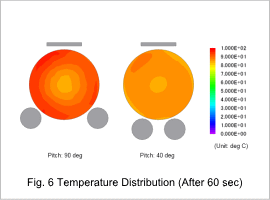Overview

To raise the resin temperature, a high-frequency preheater using dielectric heating is used.
The electrodes of the high-frequency preheater consist of parallel plate electrodes and roller electrodes. The roller electrodes rotate the tablets and heat them, so they are suitable for uniform preheating. Furthermore, by changing the pitch of the roller electrodes, the temperature distribution can be controlled. With FEA, it is possible to visualize the temperature distribution inside a material which is difficult to actually measure, making evaluations easy.
In this example, a use case is presented where the influence of the pitch of roller electrodes on the temperature distribution of a material (tablets) is evaluated.
Roller Electrode – Tablet Positional Relationship

The pitch of the roller electrodes is set to 90 deg and 40 deg. In addition, the distance between the roller electrodes and the tablets is fixed.
Dielectric Loss Density
The dielectric loss density distribution is shown in Fig. 2, and the electric field strength distribution is shown in Fig. 3.
From Fig. 2, it can be seen that when the pitch of the roller electrodes is 90 deg the loss at the circumferential surface of the tablets is high, and when the pitch is 40 deg the loss interior to the circumferential surface of the tablets is high.
From Fig. 3, it can be seen that by reducing the pitch of the roller electrodes, the electric field inside the tablets concentrates interior to their circumferential surfaces. The dielectric loss is affected by the physical characteristics, frequency, and electric field. In this use case, since the physical characteristics and frequency are common for both analysis targets, the difference in the dielectric loss distribution from the difference in the pitch of the rollers can be said to be due to the difference in the electric field strength distribution.


Temperature Distribution
The temperature distribution during heating is shown in Fig. 4 to Fig. 6, and the temperature change between the radial centers and the circumferential edges of the tablets is shown in Fig. 7 and Fig. 8.
Due to the differences in pitch of the roller electrodes, a difference also is exhibited among the temperature distributions. It can be seen that when the pitch is 90 deg heating is more prominent towards the circumferential edges of the tablets, but when the pitch is 40 deg the temperature difference between the radial centers and near the circumferential edges of the tablets is small during heating.
In this way, it is possible to control the temperature distribution of the tablets by changing the pitch of the roller electrodes.







